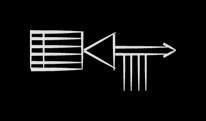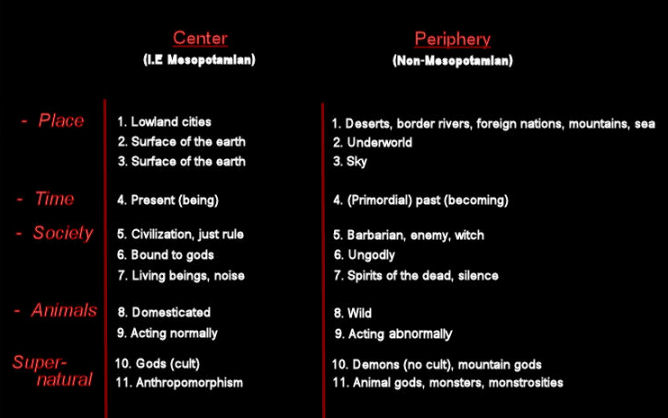The Shadow Side and
Prospects for Return
In the below reading, we continue notes on the Sumerian world
view - our intent is to consider the scholarship which has been
most effective in delimiting Sumerian notions of their world,
with the hope that this will help demystify aspects of the incantation
texts that are relient on native world view. Anyone just arriving
should first review the enenuru.net notes on the four winds, here
, paying particular attention to the easly dysnastic world maps
from Fara.
This time, we are focusing on the Netherworld concepts, and more
specifically, on the peripheral of the Sumerian world - that is
all that lies outside the Mesopotamian plateau, outside Sumerian
society itself and therefore outside the rule of the gods (as
it was the order and divine protection of the gods themselves
that contributed to the unique state of Sumerian cilivization,
according to the native view). All else was peripheral, disordered
and dangerous - the mountain gods, foriegn lands and wild animals.
These concepts of Sumerian worldview were best handled by Frans
Wiggermann in his article "Scenes from the Shadow Side"
(Mesopotamian poetic language: Sumerian and Akkadian, 2006). While
we will take notes on this article shortly, first from consideration
is given to D. Katz definition of the Sumerian netherworld, often
called by the name kur - and how kur (netherworld) and kalam (Sumerian
home country) contrast in native Sumerian thought. This understanding
will help as we come to Wiggermann's view.
The Kur-Kalam
contrast in Sumerian thought

KUR

KALAM
Wiggermann will state that "the most common term for the
Other World is kur, "mountain land", which is in opposition
to kalam, "our country". Referring to D. Katzm 2003
(The Image of the Netherworld in Sumerian Sources), she makes
some fine points which should embellish our concepts of Sumerian
Heartland and what can be termed broadly the "Other World".
She states that the term Kur became the most used word in denoting
the Netherworld in Sumerian literature - and yet, the word has
multiple meanings, it can mean as well "mountain" or
"foreign country". As Katz states, the contrast between
kalam and kur is both geo-physical and geo-political:
"The pair kur-kalam represent diametrically opposed concepts:
in relation to kalam, the heartland of Sumer in the alluvial plain
between the rivers, kur is the land that rises beyond its north
and northeastern boundaries. Both kur and kalam have two meanings
that are antithetically parallel to each other: from a geo-political
viewpoint kalam is "the land" (our homeland Sumer) as
opposed to kur "foreign land," and from a geo-physical
viewpoint kalam is the level land (of Sumer) as opposed to kur
the mountain area...In addition, the texts have positive connotations
contrary to the inimical attitude toward kur."
Kur as in Netherworld
The author speculates that it may have been this negative disposition
toward the kur land that lead the word to take on the second connotation
"hostile foreign land" or perhaps some combinations
of factors (certainly hostile foreigners such as the Gutians invaded
from this direction). How then did the word Kur come to have the
connotation Netherworld in the early Sumerian literature? - Katz
phrases this question more precisely as "how does the meaning
"Netherworld" emerge from the Bipolar Concept of Kur-Kalam?".
Her answer is that it is likely the original polarity between
kur-kalam extended, in early Sumerian mythological reasoning,
to a contrast between kalam as land of the living, and kur, as
the land of the dead.
If we don't know precisely why this was reasoned, we know that
it in any case was, due to the survival of early literature which
portrays characters traveling across land to the mountainous Netherworld.
Katz notes that this notion likely died out as early as the mid-third
millennium when exploration and territorial expansion would have
made a belief in kur as the netherworld unsustainable - although
some vestages of this notion continued in the literature (always
slow to change) new ideas of the netherworld as existing on a
vertical axis (i.e. underground) emerged with the Semitic inhabitants
of Mesopotamia. In any case, what is important here is to understand
kur (with it's different connotations) had an opposite polarity
as kalem in early Mesopotamian thought.
The Shadow Side
In Wiggermann's article "Scenes from the Shadow Side"
the author begins with a broad discussion on the subject of Mesopotamian
Cosmic Geography and the creatures thought to inhabit the fringes
of the known world. Attempts to understand the edges of the world
in a time before science and before reliable geographical information
frequently resulted in notions of the world which were, in part,
mythological. The Greek notion of cosmos is an example, on it's
fringes were thought to be imprisoned Giants and Titans, among
other things. Wiggermann will assert that this tension between
empirical geography and mythology is well attested in ancient
Mesopotamia as well.
As mentioned, this review in part overlaps with material on the
enenuru four winds thread where we takes notes on cosmic geography
for that purpose as well - Wiggermann discusses maps from the
early dynastic period which notion of the earth as four sided
and surrounded by four rivers, the center of which is marked by
the great mountain of the god Enlil. This goes some of the way
in establishing that the Sumerians, like the Greeks and other
ancient peoples, entertained ideas of the world which were a mixture
of geographical observation and mythological deduction. For these
early dynastic maps, please refer to our four winds section. An
additional map that the author discusses, which is preserved on
a well known late Babylonian tablet called the Mappis Mundi (map
of the world):

In this map, Wiggermann says, "the cosmic river surrounding
the earth is called marratu, "ocean", and in the descriptive
part of the obverse it is explained as Tâmtu, "Sea',
the name of Marduk's arch-enemy in the Enuma Elish." In fact,
the map more or less represents the way in which Marduk settled
the bodies of his vanquished opponents here and there on the sea
around the world - and so, as the author implied early on, the
map thus demonstrates perfectly the tendency of ancient cosmology
to resort to myth in dealing with the fringes of the world. There
was effectively no barrior between empirical fact and mythological
fancy in the Mesopotamian world.
The Outer Regions and their
Inhabitants
From the 4th Millennium onward the Mesopotamians steadily (if
slowly) gained knowledge about the world around them - this included
both geographical insight, but also ethnological information (the
knowledge of close and distant peoples necessarily for extensive
trade). Wiggermann writes that the acquisition of this sort of
information is observable in a wide variety of Mesopotamian literature,
and as the Mappa Mundi indicates, results in a world view
which blends with mythology, theology, and impacts certainly on
the Mesopotamian's own perspective of themselves. The author has
charted the following contrastive elements which play a part "in
the native definition of Mesopotamian civilization":

As we can see, the left column (Center / Mesopotamian) represents
the ancients own notions about themselves, and what defined their
society. The right column is what Wiggermann terms "the shadow
side", all that the Mesopotamians considered 'other', the
opposite in each case of what they saw as their society. Of course,
we might deduce that while these things were contrastive, they
had an important role in defining what was Mesopotamian, if only
by being tangible examples of opposition. The right column is
just as instructive as the left therefore.
The author continues explaining that the two spheres do not normally
intermingle, but entities from the right column such as enemies,
wild animals, spirits, demons or monsters, infringe on the civilized
world - sometimes this is seen as a sign of divine displeasure
with a king or inhabitants. There is no impassable boundary between
the two spheres. The dead, indeed, "have no choice in the
matter, but must travel westwards through the desert" says
Wiggermann.
The subject of direction that the dead must travel is made complex
by the fact that notions of the netherworld underwent significant
changes from the original Sumerian netherworld located in the
mountain land, and the Semitic concept which places it under the
earth. About the former concept, the author says: "the most
common term for the Other World is kur, "mountain land",
which is in opposition to kalam, "our country". This
kur is where the dead go, and where rebellious mountain gods,
demons, and monsters are at home. Human enemies as well descend
from the mountains, and sometimes they are so dreadful that they
cannot be distinguished from demons... Both steppe and mountains
harbor a host of wild animals which are hunted and killed by Mesopotamian
rulers from the late Uruk period onwards; they were brought to
the capital as spoils or tribute, and symbolically express the
wide extent of just rule. Assyrian kings make statues of some
of the more exotic animals, and stand them as guardians of their
palaces as apotropaic monsters."
All that is from the perphery is stands in defiance of the gods
- and in opposition to the Mesopotamian people therefore. Commenting
again on the right hand column, the author states that the "properties
of the elements in the right hand column of our scheme are more
or less interchangeable; that the inimical fuses with the demonic,
and the peripheral with death and the underworld, thus resulting
in a more or less unified image of all that is evil and conspires
against civilized life, i.e. zi-ša3-gal2. The geography involved
is marked by an increasing loss of empirical content, until finally
the Land of No Return is reached; this is the realm of the dead,
whence no traveler can bring back reliable information."
Wiggermann's discussion advance's to discuss instances of other
world imagery on Mesopotamian iconogaphy, and most fascinating
this preasents new insight on the famous bull-headed lyre from
Ur. For more, the book containing "Scenes from the Shadow
Side" can be purchased through Eisenbrauns
or one can inquire with persons familiar with the work at the
Enenuru
disucssion board
Propects
for Resurrection in Mesopotamia
As a side note, some brief consideration is given to the notion
of resurrection in Mesopotamia. The reader should be careful to
note that our treating this topic should not be taken as a confirmation
of any solid Mesopotamian precedent for notions that find common
play in Christian religion - however we seek to objectively weigh
the question. A recent article entitled "Mesopotamian Roots
for the Belief in the Resurrection of the Dead" appeared
in the publication "Relgion Compass" which presents
anthropological material on Ancient religion, frequently focusing
on Mesopotamia. The author of this article is Benjamin Studevent-Hickman,
an ancient historian specializing in the study of ancient Mesopotamia;
he currently serves as a Lecturer on Assyriology at Harvard.
The author begins by contextualizing resurrection beliefs within
the greater history of Western religion. We know the belief in
the resurrection of Christ was a major tenant of Christian faith
- less familiar may be the aspects of the belief within early
Judaism. Studevent-Hickman informs us that upon the Jews return
from the exile (the exile in Babylon), a belief in the resurrection
of the dead became more and more prevalent in certain Jewish factions:
the Pharisees and the Essenes. The author writes that while the
Sadduccees maintained no belief in resurrection of any sort, the
Essenes in the post-exilic period believed a spiritual resurrection,
and a third group, the Phrarisees, actually believed in the literal
and physical resurrection of the dead. This notion of physical
resurrection reached it foremost proponent in the person of Paul
the apostle, a Pharisee who would become demonstrably instrumental
in establishing the doctrine of the resurrection of Christ - in
turn, this was fundamental in the notion of the resurrection of
the Christian soul after death. So where does this Phariseetic
belief come from ultimately?
Studevent-Hickman asserts that the real root of the notion of
resurrection (that the dead can come back to life of some unspecified
sort, and not as any sort of salvation as the idea comes to be
with later extrapolation...), the simple idea of resurrection
was, in origin, Near Eastern: and not essentially Canaanite or
Persian as has sometimes been suggested, but Mesopotamian.
Death and Return in Mesopotamia
The author makes it clear that in Assyriological circles, the
idea that any of the Iraq civilizations believed in physical return
has little currency. Not only is there little study on this particular
question, some have flatly denied that there is any evidence for
such a belief in extent Mesopotamian literature. He chooses to
differ here however, and it may prove worth debating -
The author extends first an explanation of the Mesopotamian concept
of the Body and Soul, here he follows Abusch's analysis of the
Atrahasis material (for a summation of Abusch 1999, see this thread
Reply #9). Coming to the question of resurrection in Mesopotamia,
the author puts this into Mesopotamian terminology - it is to
return from the Netherworld, which itself is sometimes termed
"The Land of No Return." But how often do entities in
fact return from this very place in Mesopotamian literature? How
often do things come back from the dead? The author lists these
instance of divine return:
Cases of Divine Resurrection
* Namtar, the vizier of Ereshkigal travels freely to and from
the Netherworld.
* Utu has this same ability
* Inanna is released from the Netherworld (returning from the
dead) on gaining Dumuzi as her substitute. Inanna's case is particularly
indicative of a physical resurrection as she is a "slab of
meat" down there, a corpse, before Enki's creature revive
her with the plant and water of life.
* Geshtinanna goes to and returns from the N.W. semi-annually,
in concordance with her brother Dumuzi who also returns - in academic
literature, Dumuzi is often considered the proto-type of the dying
god type (Christ being another example).
More important, the author says, are the cases where humans,
not gods, have the potential to return to the land of the living:
Cases of Non-Divine Resurrection
* The cases where Ereshkigal and Inanna threaten to raise the
dead that they might "outnumber the living."
* The instance when Enkidu is physically raised in "Gilgamesh,
Enkidu and the Netherworld" and he speaks with Gilgamesh.
An additional element considered here is the poignant observation
that incantation and medical texts in Mesopotamia abundantly attest
to the belief that ghosts (largely discontented malignant ghosts)
could travel to and from the netherworld with more ease perhaps
than even the deities. He references Scurlock in order to state
that some cases of a ghost contacting a victim strongly indicate
that the contact was thought to be physical, which lends ghost
afflictions to a resurrection like (on the other hand, other incantations
give descriptions of contact that could hardly be more than metaphorical.)
However, I would disagree with the author in assessing these last
instances as offering "important" perspective on this
matter. Referring again to Katz 2003, that author stresses that
the NW is known by the epithet "the land of no return"
adding "excepting a few deities who managed to leave the
Netherworld in exchange for a substitute or ransom, only evil
spirits could leave the realm of the dead and move freely back
and fourth. The exception to the rule indicates that there is
a way out, but that one does not come from the netherworld alive."
Here Katz has stuck on a good point that Studevent-Hickman may
have overlooked - that being the fact the deities coming back
(Inanna, Dumuzi and Geshtinanna) are reliant on substitutes to
take their place in the netherworld - and so they are not precisely
achieving a victory over death, rather they are trading the grip
of death to some other unlucky soul. While they may live often
on a temporary basis, this sort of resurrection is a step again
away from the sort we see in later religions, if not more. Additionally,
Katz statement that "one does not come from the netherworld
alive" is made more potent by her assertion that the principal
example of a returning mortal, Enkidu, did not come back bodily,
but rather as a ghost or in a dream. As in the festivals of the
ghosts, we are dealing with the return of spirits.
Concluding
That said, despite ultimately hesitating about the idea of any
notion of physical resurrection in Mesopotamia, we would still
agree with Studevent-Hickman that ideas of resurrection in Mesopotamian
(especially Inanna and Dumuzi) may have traveled to the Pharisees
and from there down to Paul - after all, even if the Mesopotamians
lacked solid precedent of mortal resurrection in their beliefs,
they knew divine resurrection in specific contexts, and Jesus
to Paul was not to be thought of as less than divine.
|


